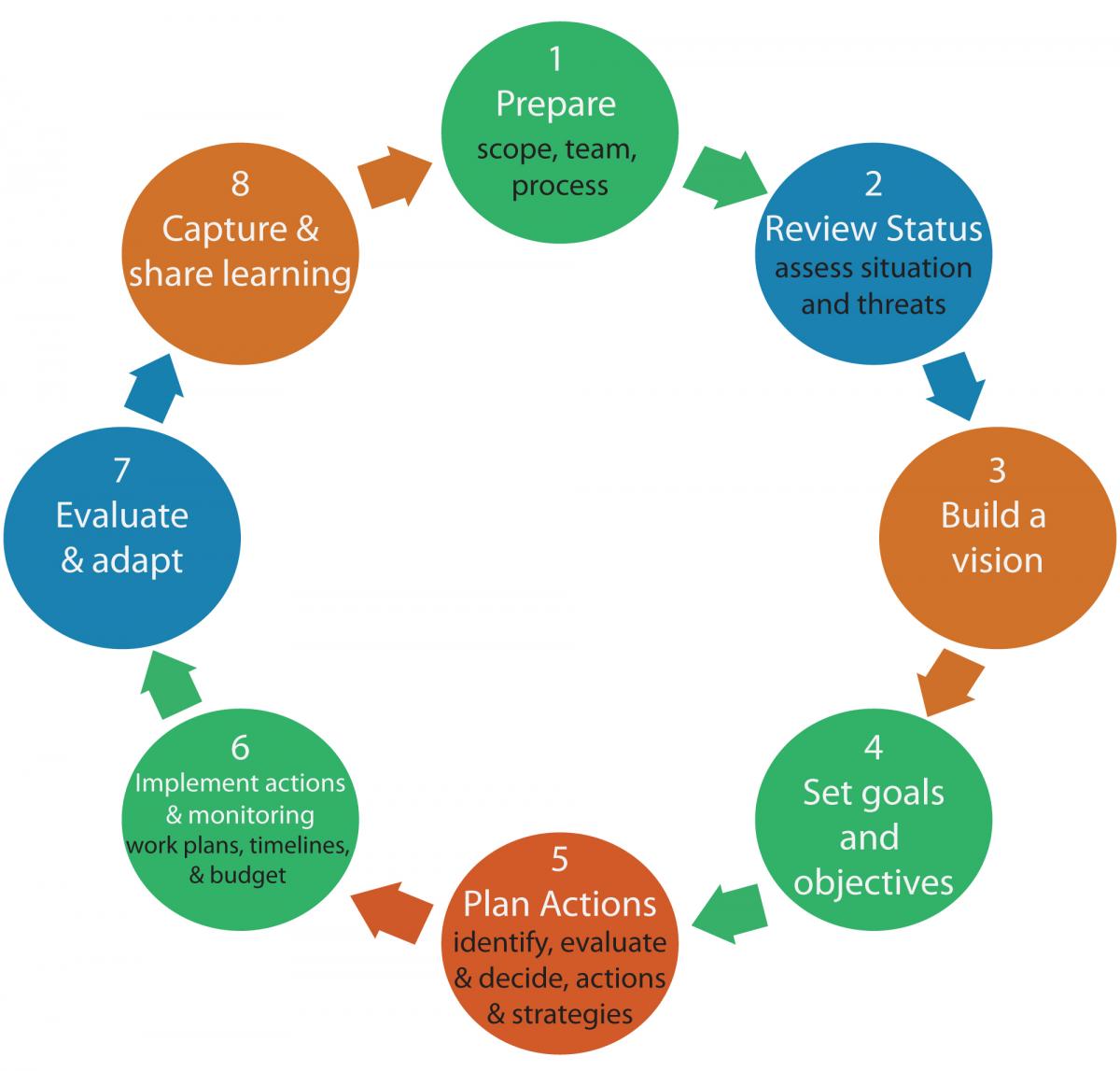The Species Conservation Planning Cycle below is based on that developed by the Conservation Measures Partnership. It has been modified to accommodate steps included in other planning methods, in particular: Population and Habitat Viability Assessments (PHVA); IUCN SSC Species Conservation Strategies (SCS); and Structured Decision Making (SDM). Different planning methods emphasize different steps in the cycle and more information on this is provided through the Planning Methods page. All of the tools referenced in the Abruzzi Table 1: Planning Tools Index have been mapped to this cycle. To browse, simply scroll through or click on the circles in the graphic below to jump to different steps in the cycle.

Step 1. Prepare
This step involves setting up the project, assembling an appropriate team, deciding what you wish to achieve and designing a planning process appropriate to the task at hand. Sub-steps included are:
Defining Scope: determining the limits of the project (taxonomic, geographic, institutional, etc.).
Defining the Team: assembling the right people for the task.
Designing the Process: determining the right environment, duration, planning method, tools, facilitation techniques and so on, for the task.
Step 2. Review Status
This step involves a thorough analysis of the situation. Sub-steps included are:
Status Review: building a description of the past and present situation of the species; current and previous distribution, population structure and numbers; and ecological, cultural and socio-economic functions and values.
Threats Analysis: completing a comprehensive diagnosis of the critical threats to the species' persistence and/or recovery.
Step 3. Build a Vision
This step involves developing a qualitative, aspirational description of the desired future state of the species.
Step 4. Set Goals and Objectives
This step involves establishing what the project will aim to achieve operationally and how project managers will measure the extent to which those aims are being achieved. Sub-steps included are:
Goals and Indicators: defining the agreed vision in operational terms, in order to help direct implementation, and to specify the measures by which planning success can be evaluated.
Objectives and Indicators: defining short-term activities that must be completed to ensure that longer-term goals are met, and the measures by which successful completion can be evaluated.
Step 5. Plan Actions
Involves determining what needs to be done to achieve the desired outcomes, including how outcomes will be monitored. Sub-steps included are:
Identifying Possible Actions and Strategies: describing what actions could be taken and when, for specific objectives to be achieved.
Predicting Outcomes: assessing the likely impact of alternative courses of action on "success", i.e., the achievement of specific objectives.
Deciding Actions and Strategies: selecting from the available alternatives in a transparent and replicable way, on the basis of all available information.
Developing a monitoring plan: to capture the information needed to allow success or failure and the reasons for it, to be evaluated.
Step 6. Implement Actions and Monitoring
This involves putting into practice the previous planning work through the development and implementation of specific work plans while ensuring sufficient resources, capacity and partners. Sub-steps included are:
Developing work plans, timelines and budgets: defining what activities are required, by whom, when and how? How will this be resourced?
Implementation Planning: promoting the conditions under which implementation is likely to occur.
Monitoring Outcomes/Outputs and Feedback: tracking progress on conservation actions and recording the results.
Step 7. Evaluate and Adapt
This involves analyzing the data collected on plan implementation and analyzing this to evaluate the effectiveness of activities and the relevance of the documented plan to the direction of these activities. Results are used to adapt the plan in the appropriate direction. Sub-steps included are:
Collate and Analyze: collating, preparing and analyzing the results of implementation.
Evaluation and Revision of Plan: assessing the efficacy of the planning document, and using the results to modify the plan as needed.
Step 8. Capture and Share Learning
Involves capturing and sharing results with key external and internal audiences to promote learning. Sub-steps included are:
Document, Learn, Share: summarizing and disseminating the results of the planning process and subsequent implementation, so that it can inform future planning efforts.
--> Next: Using Tools for Species Conservation Planning
Or, go back to Tools Library home page.


